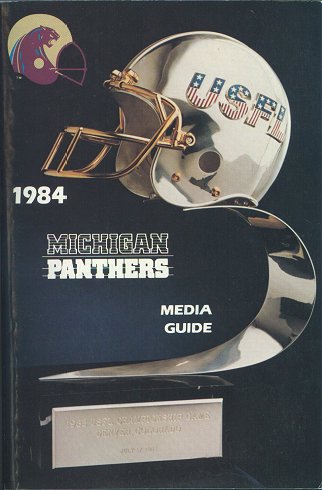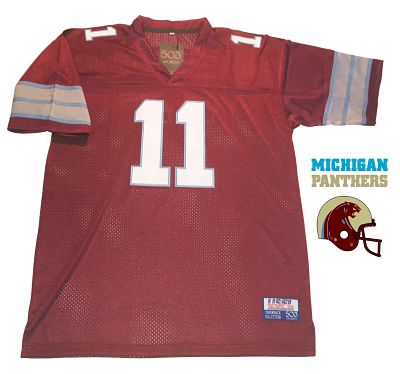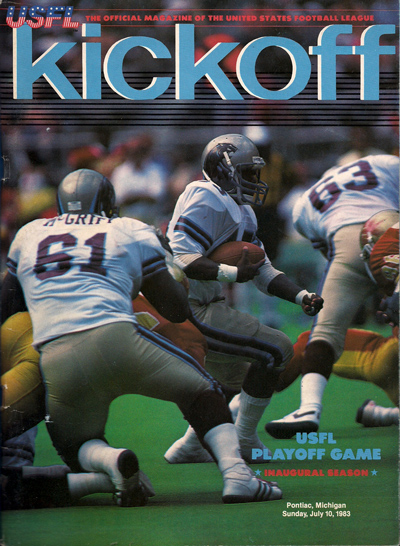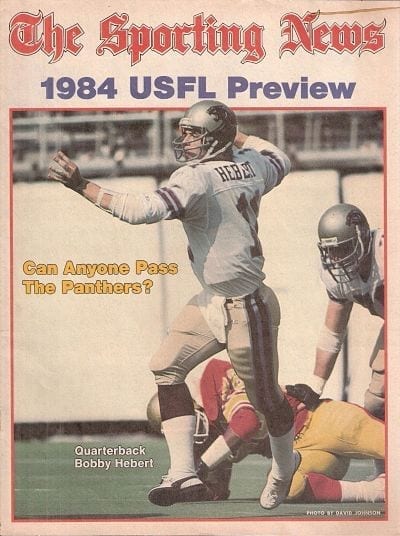United States Football League (1983-1984)
Tombstone
Born: May 11, 1982 – USFL founding franchise
Died: November 20, 1984 – The Panthers merge with the Oakland Invaders
First Game: March 7, 1983 (W 9-7 @ Birmingham Stallions)
Last Game: June 30, 1984 (L 27-21 @ Los Angeles Express)
USFL Champions: 1983
Stadium
Pontiac Silverdome
Opened: 1975
Demolished: 2017-2018
Marketing
Team Colors: Royal Plum, Champagne Silver, Light Blue & White
Ownership
Owners: A. Alfred Taubman, Max Fisher and Peter Spivak
OUR FAVORITE STUFF
Michigan Panthers
Replica Jersey
When it comes to Replica Jerseys, we turn to our friends at Royal Retros, who put extraordinary detail into their fully customizable throwback jerseys.
Free Customization Included
Any name and number
Heavyweight sewn tackle twill
100% polyester
When you make a purchase through an affiliate link like this one, Fun While It Lasted earns a commission at no additional cost to you. Thanks for your support!
Background
The Michigan Panthers were a very strong pro football entry in the springtime United States Football League. A popular springtime alternative to the Lions for long-suffering Detroit gridiron fans, the team was soon pushed out of business by the USFL’s decision to abandon its spring schedule in favor of head-to-head competition with the NFL in the fall.
1983 Championship Season
During the league’s first season in the spring of 1983, the Panthers were one of the top-spending teams in the USFL and put together a blend of NFL veterans and talented rookies. The offense, in particular, relied on a trio of rookie skill position players – unheralded Cajun quarterback Bobby Hebert out of Northwestern State (Louisiana), running back Ken Lacy from the University of Tulsa, and star wideout Anthony Carter of Michigan. Carter would have been a top NFL draft pick in 1983 but the Panthers lured him away from the senior circuit.
On defense, NFL washout John Corker terrorized the USFL in 1983 with 28.5 sacks from his outside linebacker position. Rookie safety David Greenwood earned All-USFL honors (and doubled as the Panthers’ punter).
The Panthers got off to a weak 1-4 start before catching fire midway through the season. They won 11 of their final 13 to finish the 1983 season with a 12-6 record. As the wins mounted, fans began to take notice. When the Panthers hosted the Western Conference championship playoff game against the Oakland Invaders at the Silverdome on July 10th, 1983, a USFL record 60,237 fans showed up.
The following week, the Panthers travelled to Mile High Stadium in Denver, Colorado for the first USFL Championship Game against the Philadelphia Stars. The Panthers won the game 24-22 with the decisive play coming on a 4th quarter touchdown pass from Hebert to Carter.
Longest (and Last) Game
The script flipped for the Panthers during the 1984 USFL season. Michigan got off to a hot start, racing out to a 6-0 record through the first third of the schedule. But in Week Six against the San Antonio Gunslingers, Anthony Carter broke his arm and was lost for the remainder of the season. The team went into a prolonged funk and lost eight of their next ten. The Panthers salvaged a playoff spot by rallying to win their final two games and finish 10-8.
On June 30th, 1984 the Panthers played the Los Angeles Express, quarterbacked by future Hall-of-Famer Steve Young, in a first round playoff contest. The quarterfinal game turned into an epic battle, although fewer than 8,000 fans were on hand to watch it at the L.A. Coliseum. The Express finally triumphed 27-21 in the third overtime period, on a long touchdown run by future Detroit Lion Mel Gray. At three overtimes, the game remains to this day the longest pro football game in history.
It was also the last game ever played by the Panthers. At the end of the 1984 season, USFL owners voted to shift to a fall season in 1986. The Panthers were against the move, not wishing to compete head-to-head with the NFL’s Lions. The business model shift set off a wave of relocations and mergers among the USFL franchises located in NFL markets. In the fall of 1984, the Panthers merged with the Oakland Invaders. Most of the top Panthers players, with the exception of John Corker, moved to Oakland for the USFL’s final spring season in 1985.
Aftermath
The Invaders, led by Hebert, Carter and other Michigan holdovers, returned to the USFL championship game in 1985. There they met the Baltimore Stars in what was to some degree a rematch of the 1983 USFL title game against the then-Philadelphia Stars. (The Stars were another relocation born out of the USFL’s planned switch to the fall). This time the Stars came out on top with a 28-24 victory at Giants Stadium on July 14, 1985. This was the final game in USFL history, as the league folded before staging its planned fall season in 1986.
In Memoriam
Defensive end Larry Bethea, who had 11 sacks for the Panthers in 1984, died of a self-inflicted gunshot wound on April 24, 1987 at age 30.
Defensive lineman Phil Dokes, a 1977 NFL 1st round pick who played for the Panthers in 1983, passed away on December 7th, 1989 at age 34.
Panthers offensive guard Tyrone McGriff died of a heart attack on December 9th, 2000 at age 42.
Former Panthers Head Coach Jim Stanley died of melanoma at age 76 on January 12, 2012.
Safety John Arnaud died of lung cancer at age 51 on November 10, 2012.
Downloads
1983 David Greenwood USFL Standard Player Contract
David Greenwood USFL Contract
Links
###




